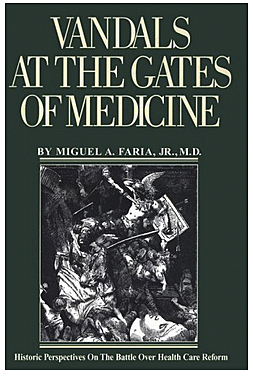
- Articles
Book review of Vandals at the Gates of Medicine. Reviewed by Donald C. Ausman, MD
The book, Vandals at the Gates of Medicine by Miguel A. Faria, Jr., M.D., is extremely interesting and unusual as it takes you through the history of primitive medicine, from the Ice Age 40,000 years ago to the Renaissance, in an attempt to solve the battle over health care reform that is now taking place.
The author speculates that organized medical care was needed, and is hypothetical about the first blunt head injury (the author is a neurosurgeon). That man recognized “the need for the care of the wounded in his clan and when he became ill from imbibing the stagnant water of a polluted pond, he also recognized the need to be provided with aid and comfort during sickness — and to be nurtured back to health.” These witch doctors had a tremendous amount of prestige and power within the tribe and were respected, as the survival of the tribe depended on them.
The author now takes the reader to the Egyptian physicians in the fifth century B.C. by quoting Herodotus, a great historian: “The art of medicine is thus divided among them. Each physician applies himself to only one disease, and no more.” Apparently, there was specialization in those days. The author also states that Egyptian doctors were regulated by the state and were given a salary by the state. “But if they act contrary to the written law, they might expect capital punishment, as the legislator considers that only few men would have knowledge better than the method of treatment observed for many years and prescribed by the best masters.” Again, the general reason for writing the book was to show that “state” medicine doesn’t belong in the hands of politicians, HMOs, or hospitals, but in the minds and mouths of patients and their doctors.
The author then discusses Mesopotamia and the empires of the near east. Again, these “physicians” were usually “physician-priests” who attempted to foretell future events or discover future knowledge, which was hidden at the time. Yet, “physicians came to be respected for their work, dedication, and their compassion.”
Next, the author covers the eastern religions and their philosophic influences around the sixth century B.C. He discusses Confucianism, Taoism, Buddhism, Zoroastrianism and Zoroastrian medicine, Manichaeism, and Hindu mythology and medicine. It as felt that all of the above had a central theme, “that individuals should recognize the basic rights of others and have an acceptance for his neighbor and fellow man” (Robert S. Jaggard, M.D.)
In Chapter 5, there is an explanation of the staff of Aesculapius and the caduceus which was found to be very interesting, and the author states that it is “the most appropriate symbol for the medical profession….The two most serious threats to the single wooden staff of Aesculapius presently are the strangulation of American medicine with the tangled and redundant red tape of government regulation and bureaucracy, and the ever-growing devastation of the all-consuming fire of the litigation juggernaut.”
Greek scholars and philosophers Socrates and his famous pupil, Plato, had a model of medical science calling for the self-imposed code of ethics, the attainment of knowledge, and the utilization of that knowledge or the benefit of humanity. Aristotle, a son of a physician, felt that conclusions can be made by careful observation and logical reasoning, rather than by superstition and mysticism.
The book states that “like the Greek religion, Greek medicine was assimilated by the Romans.” Yet, the majority of physicians in the Empire, though separated into many different sects, were composed mostly of Greek practitioners, because the Roman citizens considered the medical profession beneath their dignity.
After reviewing medical history for thousands of years, up to the Roman Empire, the author continues with his and others’ reasoning for the possibility of our country have “state” or national medicine take over after we have established the best medicine in the whole world.
Being brought up with the threat of malpractice was one reason for the high cost of medicine (e.g., neurosurgeons’ premium for malpractice protection by insurance companies was raised up to 100,000 dollars per year). “Moreover, medical practice is controlled and regulated by administrative decrees written and enforced by a myriad of governmental agencies at 25% of all U.S. health care costs….Physicians’ survival will depend on their ability to articulate eloquently to the public that they have been and remain their patients’ best advocates.
“Suffice it to say that physicians as members of a heretofore independent and honorable profession should look after the interest of their patients and refuse to go along with any government scheme that stresses cost containment at the expense of quality of care or the establishment of health care rationing in order to pacify bureaucrats who have neither the interest of the profession, nor that f the sick and vulnerable at heart.”
The author closes this excellent book with “physicians and their patients — now educated and transformed into legions of informed and vigilant citizenry — must show the legislators that they will not stand idly by and allow the demoralization, disintegration, and eventual subjugation of medicine, nor the government take-over of the American health care delivery system….Physicians, patients…citizens: the world is watching. The future of the American health care delivery system rests in your hands.”
Reviewed by Donald C. Ausman, M.D.
Originally published in Surg Neurol 1996;45:303-5.
Dr. Donald Ausman is a retired physician, 89 years old, from Milwaukee, Wisconsin. He began his career as a general practitioner in 1930 — surgeon, pediatrician, obstetrician, gynecologist, and internist; eventually he became a geriatrician. He was in practice for 60 years and is the father of Dr. James I. Ausman, the editor of Surgical Neurology.
This article may be cited as: Ausman DC. Book review of Vandals at the Gates of Medicine. Surg Neurol 1996 Mar;45(3):303-4. Available from: https://haciendapublishing.com/book-review-of-vandals-at-the-gates-of-medicine-reviewed-by-donald-c-ausman-md/.
Copyright ©1996 Surgical Neurology